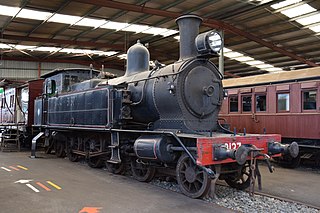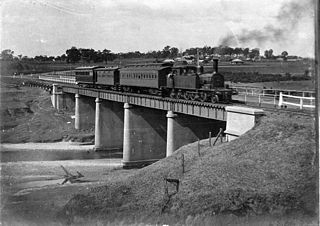
Camden Branch Line | ||||||||||||||||||||||||||||||||||||||||||||||||||||||||||||||||||||||||||||||||||||
|---|---|---|---|---|---|---|---|---|---|---|---|---|---|---|---|---|---|---|---|---|---|---|---|---|---|---|---|---|---|---|---|---|---|---|---|---|---|---|---|---|---|---|---|---|---|---|---|---|---|---|---|---|---|---|---|---|---|---|---|---|---|---|---|---|---|---|---|---|---|---|---|---|---|---|---|---|---|---|---|---|---|---|---|---|
| ||||||||||||||||||||||||||||||||||||||||||||||||||||||||||||||||||||||||||||||||||||
The Camden railway line is a closed railway line between Campbelltown and Camden in the southwestern outskirts of Sydney, Australia. The passenger service was also known as the 'Camden Tram' and affectionately as 'Pansy'. [1]

Camden Branch Line | ||||||||||||||||||||||||||||||||||||||||||||||||||||||||||||||||||||||||||||||||||||
|---|---|---|---|---|---|---|---|---|---|---|---|---|---|---|---|---|---|---|---|---|---|---|---|---|---|---|---|---|---|---|---|---|---|---|---|---|---|---|---|---|---|---|---|---|---|---|---|---|---|---|---|---|---|---|---|---|---|---|---|---|---|---|---|---|---|---|---|---|---|---|---|---|---|---|---|---|---|---|---|---|---|---|---|---|
| ||||||||||||||||||||||||||||||||||||||||||||||||||||||||||||||||||||||||||||||||||||
The Camden railway line is a closed railway line between Campbelltown and Camden in the southwestern outskirts of Sydney, Australia. The passenger service was also known as the 'Camden Tram' and affectionately as 'Pansy'. [1]
The Camden railway line was designed as a light railway and construction of the line started in 1881. The line opened on 10 March 1882 and ran between Campbelltown and Camden. The line was originally operated with Baldwin Steam Tram Motors, but these proved unsatisfactory. The NSWGR purchased two small 0-6-0 saddle tank locomotives from Manning Wardle, which were a standard K Class design. These became the S-292 class. The line carried freight and passengers but was rarely busy. From 1901, the line was upgraded to railway standard and typically operated by an E class (later Z20 class locomotive in the 1924 reclassification of locomotives) 2-6-4 side-tank locomotives. Starting in the 1950s, the usual locomotive power on the Camden Branch Line was provided by C30 class locomotives. Passenger trains in the early years used lightweight KA Tramcars which were specially built for the line, but were also used at Yass and Carlingford. Starting around 1917 the trains typically ran with a CCA type end-platform carriage, usually boosted in capacity by various independent carriages when the occasion demanded.
Due to the steepness of the ruling gradient of 1 in 19 (reported to be the steepest grade used by adhesion locomotives in Australia) between Campbelltown and Kenny Hill, there were often multiple attempts made at ascending the grade. Passengers would sometimes have to disembark from the train and walk alongside it, leaving their bags on board. When trains could not successfully ascend the hill, the train would be divided and the second half of train (invariably the part where the passengers were carried) would be left standing on the line until the first half of the train had been stowed at Campbelltown. Such delays on the line were a source of annoyance and inconvenience for passengers. The main source of income for the line was the coal loader at Narellan and the Dairy Farmers Milk Co-operative depot at Camden. The line closed on 1 January 1963. [2]
Traces of the original line's route can still be seen along looking up Kirkham Lane from Camden Valley Way, including a wooden bridge along this section towards Narellan. The elevated section as it passed through this low-lying area are visible – the nearby Nepean River would flood the land around this area when it burst its banks. Cuttings through Kenny Hill are also visible from parts of Narellan Road near the Mount Annan Botanical Gardens. Photographs of the line are on display in the Camden Historic Society Museum in Camden.
The song 'The Camden Tram' by Buddy Williams, which is featured in the repertoire of the Camden Community Band, commemorates the train. [1]
Every year, on Good Friday, three or four special trains were run from Sydney to Maryfields, to cater for public attendance to the Via Crucis religious ceremony held on the grounds of the Franciscan Brothers monastery near Campbelltown. [3] This required out-of-the-ordinary working over the branch line, which also included the provision of an additional locomotive at both the front and rear of each train. Maryfields, a platform opposite the entrance to the monastery, had a platform suitable for an 8 or 9-car train. [4]
The intermediate stations from the Campbelltown end were Maryfields (formerly known as 'Rudds Gate'), Kenny Hill, Currans Hill, Narellan, Grahams Hill, Kirkham, and Elderslie, with the line terminating at Camden. These stations have disappeared.

The grade of a physical feature, landform or constructed line refers to the tangent of the angle of that surface to the horizontal. It is a special case of the slope, where zero indicates horizontality. A larger number indicates higher or steeper degree of "tilt". Often slope is calculated as a ratio of "rise" to "run", or as a fraction in which run is the horizontal distance and rise is the vertical distance.

Campbelltown railway station is located on the Main South line, serving the Sydney suburb of Campbelltown. It is served by Sydney Trains T8 Airport & South line services and NSW TrainLink services to Moss Vale, Goulburn, Canberra, Griffith and Melbourne.

The Nilgiri Mountain Railway (NMR) is a 1,000 mmmetre gauge railway in Nilgiris district, Tamil Nadu, India, built by the British in 1908. The railway is operated by the Southern Railway and is the only rack railway in India.

Liverpool railway station is a heritage-listed railway station located on the Main South line, serving the Sydney suburb of Liverpool in Australia. It is served by Sydney Trains T2 Inner West & Leppington, T3 Bankstown and T5 Cumberland services. It was added to the New South Wales State Heritage Register on 2 April 1999.

The South Coast Railway is a commuter and goods railway line from Sydney to Wollongong and Bomaderry in New South Wales, Australia. Beginning at the Illawarra Junction, the line services the Illawarra and South Coast regions of New South Wales.

Macarthur railway station is located on the Main South line, serving the Sydney suburb of Campbelltown. It is served by Sydney Trains T8 Airport & South and NSW TrainLink Southern Highlands Line services. It is the southern extremity of the electrified Sydney Trains network.

The Belmont railway line is an abandoned coal haulage and passenger rail line from Adamstown, New South Wales to Belmont, New South Wales. This was a private railway, being the property of the New Redhead Estate and Coal Company and was generally known as the Belmont Branch. The line closed in December 1991. It has since been converted into a cycleway or rail trail - The Fernleigh Track.

Sydney, the largest city in Australia, has an extensive network of passenger and freight railways. The passenger system includes an extensive suburban railway network, operated by Sydney Trains, a metro network and a light rail network. A dedicated freight network also exists. Future expansion of the light rail network includes the Parramatta Light Rail. Existing light rail services are the Inner West Light Rail and the CBD & South East Light Rail.
The Port Melbourne railway line is a former railway line in Melbourne, Australia, opened in September 1854, that is now a light rail line. It was instigated by the Melbourne and Hobson's Bay Railway Company to carry passengers arriving in Victoria at Station Pier and to alleviate the high cost of shipping goods using small vessels up the Yarra River to Melbourne. The line's conversion to light rail occurred in 1987; it is now served by tram route 109.

The Main Southern Railway is a major railway in New South Wales, Australia. It runs from Sydney to Albury, near the Victorian border. The line passes through the Southern Highlands, Southern Tablelands, South West Slopes and Riverina regions.
The Main Western Railway is a major railway in New South Wales, Australia. It runs through the Blue Mountains, Central West, North West Slopes and the Far West regions. It is 825 kilometres (513 mi) with 484 kilometres (301 mi) operational & 341 kilometres (212 mi) under construction & repairs.
The railways of New South Wales, Australia, use a large variety of passenger and freight rolling stock. The first railway in Sydney was opened in 1855 between Sydney and Granville, now a suburb of Sydney but then a major agricultural centre. The railway formed the basis of the New South Wales Government Railways. Passenger and freight services were operated from the beginning. By 1880, there was a half hourly service to Homebush.
The Rogans Hill railway line was a short-lived railway line in the north-western suburbs of Sydney, Australia.
The Crookwell railway line is a disused branch railway line in the south of New South Wales, Australia. It has never officially been closed. It branched from the Main South line at North Goulburn and passed north through the localities of Kenmore and Roslyn to the town of Crookwell. The line is set to be converted into a rail trail.

The C30 class tank engine is a class of steam locomotives built by Beyer, Peacock & Company and Eveleigh Railway Workshops for the New South Wales Government Railways of Australia.

The 70 class were a class of diesel-hydraulic locomotives built by Commonwealth Engineering, Granville for the New South Wales Department of Railways in 1960–61. They were ordered to replace steam locomotives at Port Kembla.

The Kurrajong railway line was a railway line in the distant rural western suburbs of Sydney, Australia. It was an extension of the branch off the Main Western line from Blacktown to Richmond and was operated by the New South Wales Government Railways.

The Olympic Park railway line is a railway line linking the Sydney Olympic Park precinct to the Main Suburban railway line at Flemington and Lidcombe. Originally opened as the Abattoirs branch in 1911, it was rebuilt and reopened as the Olympic Park railway line in 1998. Passenger services have since been running on it as the Olympic Park Line.

Royal National Park railway station is located in Audley, New South Wales and services travellers to the Royal National Park. It is the terminus of the Royal National Park railway line, formerly part of the Sydney commuter rail network and now operated by the Sydney Tramway Museum. The station opened in 1886 and was served by trains on the Sydney network until 1991 when the Royal National Park railway line was closed due to low patronage. The line and station were transferred to the Sydney Tramway Museum and re-opened in May 1993 for heritage tramway operations.

Camden railway station was a railway station in Camden and the terminus of the Camden line in South Western Sydney. It opened along with the line on 10 March 1882 and closed along with it on 1 January 1963. Apart from the station master's residence, the station is no longer extant.